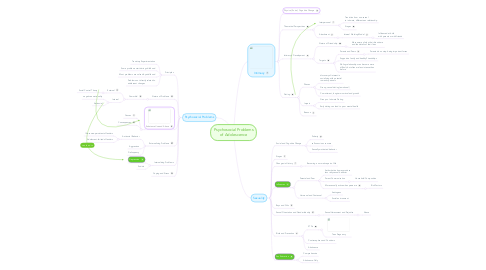
1. Sexuality
1.1. Social and Cognitive Change
1.1.1. Puberty
1.1.2. self-conscious concern
1.1.3. Sexually motivated behavior
1.2. Stages
1.3. Changes in History
1.3.1. Becoming a normative part of life
1.4. Influences
1.4.1. Parental and Peer
1.4.1.1. Authoritative homes produce less risky sexual behavior
1.4.1.2. Parent Communication
1.4.1.2.1. Household Composition
1.4.1.3. More sexually active when peers are
1.4.1.3.1. Risk Factors
1.4.2. Hormonal and Contexual
1.4.2.1. Androgens
1.4.2.2. Social environment
1.5. Boys and Girls
1.6. Sexual Orientation and Gender Identity
1.6.1. Sexual Harassment and Prejudice
1.6.1.1. Abuse
1.7. Risks and Prevention
1.7.1. STDs
1.7.1.1. Teen Pregnancy
1.7.2. Contraceptives and Condoms
1.7.3. Abstinence
1.8. Sex Education
1.8.1. Comprehensive
1.8.2. Abstinence-Only
2. Psychosocial Problems
2.1. Principles
2.1.1. Transitory Experimentation
2.1.2. Some problems start during childhood
2.1.3. Most problems are solved by adulthood
2.1.4. Problems not directly related to adolescent changes
2.2. Nature of Problems
2.2.1. Comorbid
2.2.1.1. External
2.2.1.1.1. Social Control Theory
2.2.1.2. Internal
2.2.1.2.1. negative emotionality
2.2.1.2.2. Antisocial
2.3. Substance Use and Abuse
2.3.1. Causes
2.3.2. Consequences
2.4. Externalizing Problems
2.4.1. Antisocial Behavior
2.4.1.1. life-course-persistent offenders
2.4.1.2. Adolescent-limited offenders
2.4.2. Aggression
2.4.3. Delinquency
2.5. Internalizing Problems
2.5.1. Depression
2.5.2. Suicide
2.6. Coping and Stress
3. Intimacy
3.1. Physical, Social, Cognitive Change
3.2. Theoretical Perspectives
3.2.1. Interpersonal
3.2.1.1. Transition from non-sexual to intimate, different-sex relationship
3.2.1.2. Stages
3.2.2. Attachment
3.2.2.1. Internal Working Model
3.2.2.1.1. Influenced at birth with parents or with friends
3.3. Intimacy's Development
3.3.1. Nature of Friendship
3.3.1.1. More aware of who their friends are and the details of their lives
3.3.2. Targets
3.3.2.1. Parents and Peers
3.3.2.1.1. Parents do no stop being important forces
3.3.2.2. Supportive family and healthy Friendships
3.3.2.3. Sibling relationships can become more difficult, but often are less intense than before
3.4. Dating
3.4.1. Phases
3.4.1.1. discovery of interest in socializing with potential romantic partners
3.4.1.2. Group, casual dating (emotional)
3.4.1.3. Commitment, long-term survival and growth
3.4.2. Impact
3.4.2.1. Group vs. Intimate Dating
3.4.2.2. Early dating can lead to poor mental health
3.4.3. Reason
